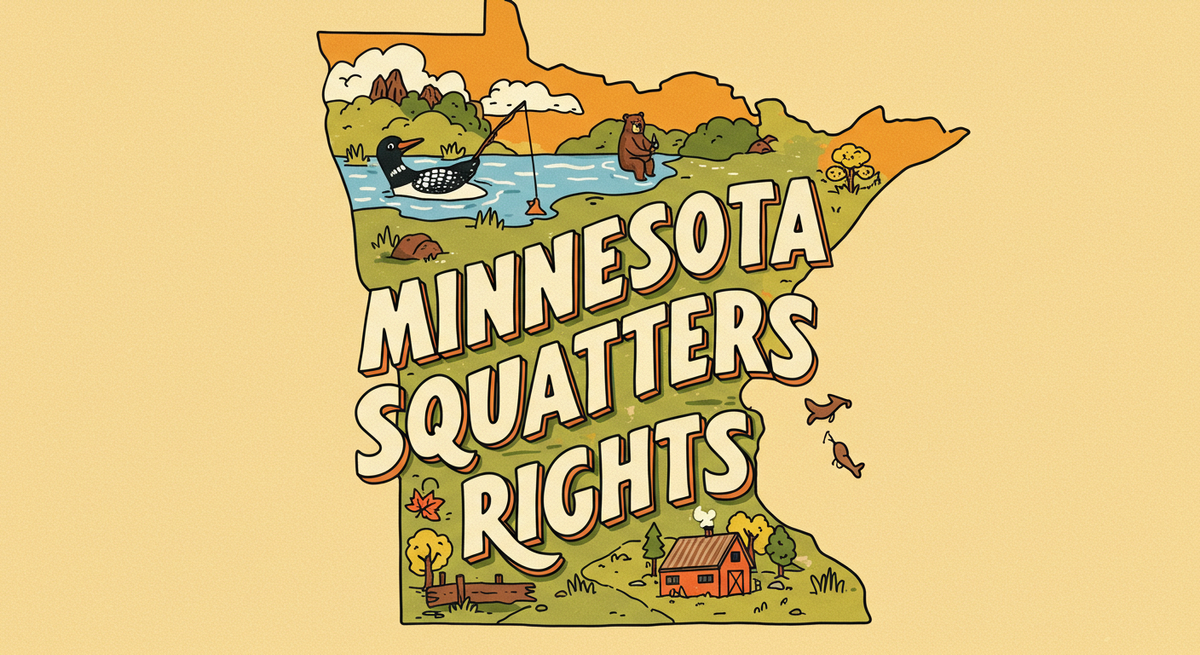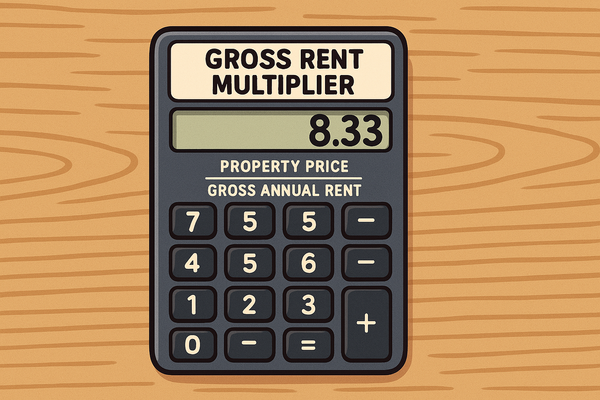Minnesota Squatters Rights Guide: Understanding Adverse Possession Laws
Did you know Minnesota requires one of the longest adverse possession periods in the nation? At 15 years, it's a property owner's best friend when it comes to protection against squatters.

Did you know Minnesota requires one of the longest adverse possession periods in the nation? At 15 years, it's a property owner's best friend when it comes to protection against squatters. This guide will walk you through everything you need to know about squatters rights in the Land of 10,000 Lakes.
- Definition of squatters vs. trespassers in Minnesota
- Trespassing is a criminal offense that involves entering property without permission.
- Squatting typically involves a person living on a property for an extended period without authorization.
- In Minnesota, squatters may potentially claim legal rights to a property through adverse possession after meeting strict requirements.
- Basic overview of adverse possession in Minnesota
- Minnesota requires one of the longest occupation periods in the United States: 15 consecutive years.
- Property tax payments must be made for at least 5 consecutive years during occupation.
- The "OCEAN" criteria (Open, Continuous, Exclusive, Adverse, Notorious) must be strictly followed.
- Why property owners should understand these laws
- Protecting your property investment requires knowledge of potential legal challenges.
- Understanding the timeline helps property owners take prompt action against unauthorized occupants.
- Prevention strategies become more effective when based on legal requirements specific to Minnesota.
- Historical purpose of adverse possession laws
- Originally designed to ensure productive use of land rather than abandonment.
- Encourages property owners to monitor and maintain their real estate.
- Helps resolve boundary disputes and unclear property titles over time.
Squatter Snippet: Real Case from Minnesota
In 2005, Marc Barone discovered he had become an accidental squatter in one of Minnesota's most bizarre property disputes. After paying $62,900 cash for what he believed was a double-wide manufactured home on 10 acres near Kerrick, Minnesota, Barone was shocked to learn years later that his house was actually sitting entirely on his neighbor John Jurek's property. The land Barone had legitimately purchased turned out to be an adjacent tamarack swamp too wet to build on.
This extraordinary situation emerged from multiple oversights in the property transfer process. Despite the land changing hands several times, no surveys were conducted that could have detected the error. This created an astonishing legal paradox where Barone couldn't sell the house because he didn't own the land, and Jurek couldn't sell the land because there was a house on it he didn't own.
The case highlights how even legitimate property transactions can create unintentional squatting situations, demonstrating why understanding Minnesota's property laws is crucial for all property owners.
Key Timeline: Statutory Period in Minnesota
- Required occupation period: 15 years in Minnesota
- Continuous possession requirement: Occupation without significant gaps
- Comparison with neighboring states:
- Wisconsin: 20 years
- Iowa: 10 years
- North Dakota: 20 years
- South Dakota: 20 years
- Timeline exceptions:
- Military service may pause the timeline
- Legal incompetence/disability may extend deadlines
- Courts consider reasonable interruptions due to seasonal factors
CHART: Adverse Possession Timeline Comparison
| State | Required Years | Special Conditions |
|---|---|---|
| Minnesota | 15 years | 5 years of property tax payments |
| Wisconsin | 20 years | Color of title reduces to 10 years |
| Iowa | 10 years | Tax payment not strictly required |
| North Dakota | 20 years | Color of title reduces to 10 years |
| South Dakota | 20 years | Tax payment required in most cases |
Quick Guide for Property Owners
Minnesota's 15-year requirement for adverse possession creates a significant barrier for potential squatters – making it one of the most property owner-friendly states in the nation. However, a shocking aspect of Minnesota's property law relates to holdover tenants: if a tenant remains in a property after their lease expires for three or more years before the property owner initiates eviction proceedings, the owner loses the right to file for eviction on that basis under Minnesota Statute § 504B.311. This unusual provision highlights why immediate action is crucial when dealing with unauthorized occupants.
Property owners should also know that seemingly minor details can make or break a squatter case. In one recent Minnesota Supreme Court case (St. Paul Park Refining v. Domeier), the court examined whether an adverse possession claim requires tax payments on the exact disputed portion of property or merely "substantially all" of the relevant parcel. These technical distinctions demonstrate why understanding Minnesota's specific requirements is critical for protecting your real estate investments.
- Know your timeline: Squatters can claim rights after 15 years of continuous occupation
- Documentation matters: Keep property records, tax receipts, and inspection logs
- Regular monitoring required: Vacant properties are most vulnerable
- Legal obligation: Self-help eviction methods are illegal in Minnesota
- Act quickly: The longer squatters remain, the stronger their potential claim
- Proper notices: Follow legal procedures when removing unauthorized occupants
Prevention: Protecting Your Property
Minnesota's harsh winters create unique challenges for property monitoring, particularly for seasonal or vacation properties. Snow accumulation can make regular inspections difficult, potentially leaving properties vulnerable for extended periods. Meanwhile, the state's urban-rural divide means Minneapolis and St. Paul properties face different squatting risks than rural Minnesota properties. Urban abandoned properties often attract sophisticated squatters familiar with legal protections, while rural properties may experience slower law enforcement response times but benefit from closer community monitoring.
Prevention strategies must account for these Minnesota-specific factors while establishing comprehensive property protection systems that work year-round.
- Regular inspections:
- Visit property at least quarterly
- Document each visit with photos/notes
- Consider remote monitoring systems for winter months
- Effective security measures:
- Secure all entry points
- Consider alarm systems
- Install motion-activated lighting
- Clear signage:
- Post "No Trespassing" signs visibly
- Mark property boundaries clearly
- Property management options:
- Hire professional management for vacant properties
- Consider rental options for long-term vacancies
- Documentation practices:
- Keep tax payment records
- Maintain utility connections
- Take dated photographs regularly
CHART: Property Risk Assessment Matrix
| Property Type | Risk Level | Recommended Prevention | Estimated Cost |
|---|---|---|---|
| Vacant Land | High | Boundary markers, signage, quarterly inspections | $500-$1,000/year |
| Abandoned Building | Very High | Security system, property management, monthly inspections | $2,000-$5,000/year |
| Seasonal Property | Medium | Remote monitoring, community watch involvement, storm shutters | $1,000-$3,000/year |
| Investment Property | Low-Medium | Professional property management, tenant screening, security features | $1,500-$4,000/year |
Removing Squatters: Step-by-Step Process
Minnesota's eviction process follows specific legal procedures that property owners must follow precisely. Attempting "self-help" eviction methods like changing locks, removing belongings, or physically removing occupants is strictly prohibited under Minnesota law and could expose property owners to significant legal liability. Only the sheriff has authority to physically remove squatters after the court process is complete.
The typical eviction timeline in Minnesota ranges from two weeks to three months, depending on court calendars, potential continuances, and whether the squatter appeals the decision. This underscores the importance of taking prompt action upon discovering unauthorized occupants.
- Document the situation:
- Take photos/video of occupation
- Gather ownership documents
- Issue proper written notice to vacate
- Typically a 5-day notice to quit
- Must clearly identify squatters and demand they vacate immediately
- File appropriate legal complaint:
- Unlawful detainer action in Minnesota District or Housing Court
- Include all required documentation
- Attend court hearing
- Present evidence of ownership
- Demonstrate unauthorized occupation
- If successful, obtain Writ of Recovery of Premises and Order to Vacate
- Court immediately issues this document
- Authorizes sheriff to remove squatters
- Sheriff enforces removal, not property owner
- Writ typically stayed up to seven days
- Sheriff posts writ at property
- Squatters given 24 hours to vacate
- What NOT to do:
- Do not change locks yourself
- Do not shut off utilities
- Do not remove squatter's belongings
- Do not threaten or intimidate
- Do not use physical force
- Timeline expectations:
- Notice period: 5 days
- Court processing: 2-4 weeks
- Eviction enforcement: 1-7 days after judgment
CHART: Eviction Process Timeline
The Minnesota eviction timeline follows specific statutory requirements under Minnesota Statute § 504B. Court dates must be scheduled between seven and fourteen days from when the summons is issued, creating a relatively expedited initial hearing process compared to some other states. However, court backlogs, especially in Hennepin and Ramsey counties, can extend this timeline significantly. Rural counties typically process evictions more quickly due to lower case volumes.
Recent Minnesota court data shows the average eviction process takes approximately 30-45 days from initial filing to sheriff enforcement when no significant delays occur. Property owners should budget time and resources accordingly when planning for potential eviction proceedings.
[Discovery of Squatter] → [Documentation: 1-2 days] → [Notice to Vacate: 5 days] →
[Court Filing: 1 day] → [Waiting for Hearing: 7-14 days] → [Court Hearing: 1 day] →
[If successful, Wait for Order: 1-3 days] → [Sheriff Enforcement: 1-7 days] → [Property Returned]
Total estimated timeline: 2-8 weeks
Legal Requirements for Adverse Possession
Minnesota courts strictly interpret the "OCEAN" criteria for adverse possession claims. The Minnesota Supreme Court has consistently required clear and convincing evidence for each element, placing a substantial burden of proof on potential adverse possessors. Notable cases like Ganje v. Schuler (2005) and Rogers v. Moore (2018) have reinforced the rigorous standards applied to each element, particularly regarding the tax payment requirement and the continuous possession standard.
The hostility element in Minnesota follows an objective standard - focusing on occupation without legal right rather than the squatter's subjective beliefs about ownership. This interpretation differs from some neighboring states that use a subjective standard requiring the adverse possessor to demonstrate a genuine belief in their ownership rights.
- Hostile Claim
- Requires possession without the owner's permission
- Minnesota follows an objective standard
- Common misunderstanding: "hostile" doesn't mean aggressive behavior
- Actual Possession
- Physical occupation is required
- Must use property as a typical owner would
- Evidence includes improvements, maintenance, utility connections
- Open and Notorious Possession
- Occupation must be visible to community
- No attempt to hide or conceal presence
- Neighbors would recognize occupant as apparent owner
- Exclusive Possession
- Squatter must maintain sole control
- Cannot share property with legal owner
- Must exclude others as an owner would
- Continuous Possession
- Full 15 years without significant interruption
- Seasonal properties allow reasonable absences
- Military service may pause timeline
CHART: Adverse Possession Requirements Matrix
| Requirement | Required in Minnesota? | Evidence Courts Accept | Common Pitfalls |
|---|---|---|---|
| Hostile Claim | Yes | Lack of owner permission, acting as owner | Permission from any prior owner can defeat claim |
| Actual Possession | Yes | Improvements, maintenance, utility connections | Minimal or sporadic use insufficient |
| Open & Notorious | Yes | Visible occupation, community recognition | Concealed occupation defeats claim |
| Exclusive | Yes | Sole control, excluding others | Sharing with others undermines claim |
| Continuous | Yes | 15 years of possession, limited gaps | Significant breaks reset 15-year clock |
Frequently Asked Questions
- "Can I remove squatters myself?"
- No, self-help eviction is illegal in Minnesota
- Only the sheriff can physically remove squatters after court order
- "Do squatters have to pay property taxes?"
- Yes, Minnesota requires 5 years of tax payments for adverse possession
- Tax payment strengthens adverse possession claim
- "What's the difference between a squatter and a trespasser?"
- Trespassers: Short-term unauthorized presence (criminal offense)
- Squatters: Ongoing occupation with potential adverse possession claim (civil matter)
- "Who should I contact first - police or sheriff?"
- For immediate safety concerns: Police
- For eviction enforcement: Sheriff
- "Can squatters claim abandoned property?"
- Yes, if all adverse possession requirements are met
- Abandonment may actually strengthen their claim
- "How quickly can I evict a squatter?"
- Typical timeline: 2-8 weeks
- Factors affecting timeline: court schedule, evidence quality, appeals
CHART: Decision Tree for Property Owners
Minnesota's specific laws create a clear decision path for property owners encountering unauthorized occupants. Under Minnesota criminal statutes, recent entry (typically within 24 hours) may constitute criminal trespass, allowing police intervention. Beyond this window, the situation generally transforms into a civil matter requiring formal eviction proceedings.
Minnesota's law enforcement protocols typically direct officers to classify longer-term occupation as a civil matter even when the entry was clearly unauthorized. This practical application of the law means property owners must understand the critical distinction between criminal trespass and civil squatting to select the appropriate response path.
Discovered Someone on Your Property
├── Emergency/Dangerous Situation? → Yes → Call Police
│ └── No ↓
├── Recent Entry (Less than 24 hours)? → Yes → Call Police (Trespasser)
│ └── No ↓
├── Evidence of Established Occupation? → Yes → Legal Eviction Process Required
│ └── No ↓
└── Uncertain Situation → Consult Attorney Before Taking Action
Recent Legislative Changes in Minnesota
Minnesota's legislature has recently considered several bills addressing squatting concerns, though major changes to the state's adverse possession framework remain limited. In 2023, Senate File 3589 introduced by Senator Westrom proposed strengthening property owner protections against squatters, specifically targeting individuals who produce fraudulent lease documents to claim legitimate occupancy.
This legislative attention follows high-profile squatting incidents in Minneapolis, including the widely reported 2023 case of unauthorized occupants infiltrating the Lonoke Apartments, where residents reported violent encounters with squatters and deteriorating living conditions. These incidents have prompted renewed legislative interest in balancing Minnesota's strong adverse possession requirements with more streamlined processes for removing clearly unauthorized occupants.
While Minnesota's 15-year adverse possession requirement remains unchanged, procedural adjustments to the eviction process continue to evolve. Property owners should monitor potential legislative developments that may impact their rights and responsibilities regarding unauthorized occupants.
- Recently Passed Laws:
- Senate File 3589: Proposed in 2023, focused on fraudulent lease documentation
- Impact on property owners: Would provide faster removal processes for clearly fraudulent occupancy claims
- Current status: Under legislative consideration
- Pending Legislation:
- Several bills addressing "squatter crisis" prevention
- Proposed changes: Expedited eviction processes for verified squatting situations
- Expected implementation: Ongoing legislative discussion
- Legislative Trends:
- Increased attention to urban squatting incidents
- Balance between property rights and housing concerns
- Focus on fraudulent documentation as key enforcement trigger
State-Specific Considerations
- Color of Title in Minnesota:
- Definition: Document suggesting ownership but legally invalid
- Impact on statutory period: Not required but may strengthen claim
- Documentation requirements: Courts consider document validity
- Burden of proof requirements:
- Squatter must prove all elements of adverse possession
- "Clear and convincing evidence" standard applied
- Higher standard than typical civil cases
- Recent legal developments:
- St. Paul Park Refining v. Domeier case reviewing tax payment requirements
- Supreme Court examining "substantially all" standard for partial parcels
- May impact future adverse possession claims on property portions
- How Minnesota differs from neighboring states:
- Longer statutory period than Iowa (15 vs. 10 years)
- Shorter than Wisconsin, North Dakota, South Dakota (all 20 years)
- Tax payment requirement more stringent than some neighboring states
CHART: Minnesota vs. Neighboring States Comparison
| Factor | Minnesota | Wisconsin | Iowa | North Dakota | South Dakota |
|---|---|---|---|---|---|
| Statutory Period | 15 years | 20 years | 10 years | 20 years | 20 years |
| Color of Title Impact | Not required | Reduces to 10 years | Not required | Reduces to 10 years | Not required |
| Tax Payment Required | Yes - 5 years | No | No | No | Yes |
| Special Conditions | None | Fencing requirement | None | Cultivation requirement | None |
| Strictness Rating | 4/5 | 3/5 | 2/5 | 4/5 | 4/5 |
Advanced Legal Process
- Court proceedings in detail
- Minnesota District or Housing Court jurisdiction
- Formal summons and complaint requirements
- Evidence standards for ownership documentation
- Evidence requirements
- Property deed and tax records
- Documentation of unauthorized occupation
- Timeline evidence for occupation period
- Potential outcomes and appeals
- Writ of Recovery if successful
- Appeal options for both parties
- Stay of eviction during appeal process
- Monetary judgments and damages
- Potential recovery for property damage
- Lost rent considerations
- Costs of legal proceedings
- Impact on property title
- Title clearing after successful eviction
- Documentation for future transactions
- Disclosure requirements for property sales
- Special provisions for legally incompetent individuals
- Extended timelines may apply
- Guardian appointment process
- Court protections for vulnerable individuals
Real-World Examples
The Accidental Squatter: Barone v. Jurek
Marc Barone's case of accidentally building on his neighbor's land represents one of Minnesota's most unusual adverse possession situations. After discovering his house was entirely on John Jurek's property due to survey errors, both parties faced a legal paradox: Barone couldn't sell the house because he didn't own the land, and Jurek couldn't sell the land because a house he didn't own sat on it. This case highlights the importance of professional surveys when purchasing property.
Urban Squatting: The Lonoke Apartments Case
In 2023, Minneapolis residents of the Lonoke Apartments reported violent encounters with unauthorized occupants who had infiltrated the building. This high-profile case demonstrated the challenges of urban squatting situations, where unauthorized occupants can blend with legitimate tenants in multi-unit buildings. The case prompted calls for legislative action to address urban squatting concerns.
Boundary Dispute: Peterson v. Larson
A 2016 Minnesota case involved neighboring property owners disputing a boundary line where one owner had maintained and used a portion of land beyond their technical property line for over 20 years. The court ultimately recognized adverse possession of the disputed strip based on continuous maintenance, fence installation, and exclusive use despite the neighboring owner's knowledge. This case demonstrates how adverse possession can resolve long-standing boundary uncertainties.
Resources
- Current Minnesota Squatters Rights Laws:
- Minnesota Statute § 541.02 - Adverse possession requirements
- Minnesota Statute § 504B - Eviction procedures
- Last updated: 2023
- Recent/Pending Legislation:
- Minnesota Senate Republican Caucus - Information on proposed anti-squatting legislation
- Bill status: In committee
- Minnesota Judicial Branch:
- Minnesota Courts Eviction Resources - Forms and procedures
- Housing Court Information - Hennepin County specific resources
- Legal Aid Resources:
- Minnesota Legal Aid - Free legal assistance for qualifying individuals
- Minnesota State Bar Association - Attorney referrals
Legal Disclaimer
DISCLAIMER: The information provided in this guide is for general informational purposes only and should not be construed as legal advice on any subject matter. The content contained herein does not establish an attorney-client relationship.
This guide about Minnesota squatters' rights and adverse possession laws is intended to provide general information and should not be relied upon as legal advice. Laws and regulations regarding property rights, adverse possession, and eviction procedures vary by jurisdiction and may change over time. The information presented here may not reflect the most current legal developments or address your specific situation.
No reader should act or refrain from acting based on information in this guide without first seeking professional legal advice. Property owners dealing with squatters should consult with a qualified attorney licensed to practice in Minnesota for advice tailored to their particular circumstances.
The authors, publishers, and distributors of this guide expressly disclaim all liability in respect to actions taken or not taken based on any or all of the contents of this document. They shall not be responsible for any errors or omissions in this information or any consequences arising from its use.
This guide is provided "as is" without warranty of any kind, either express or implied, including but not limited to implied warranties of merchantability, fitness for a particular purpose, or non-infringement.
Copyright © 2025. All rights reserved.





